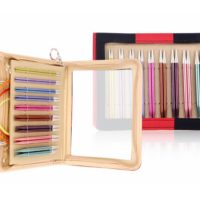You’re knitting along, and you run out of yarn. There are a few ways to attach a new ball – you can spit splice, just tie a knot, or try this technique – the Russian Join. The Russian Join is ideal when you’re working with a cotton or acrylic yarn that will not felt (for spit splicing).
Information on things you’ll see in this video:
The poncho on the mannequin is my Rodeo Drive Poncho, pattern + video tutorial.
The scarf I’m wearing is called Hitchhiker, knit with Hazel Knits DK Lively.
The yarn I use for demonstration is Malabrigo Chunky.
The nail color I’m wearing is CND Shellac polish, in color “Asphalt”.



That was a clever, and cleaner way to join yarn. I really liked those little scissors!
Very good information! Thanks 🙂
Absolutely love this I have always had trouble making a smooth join knitting and crochet thanks can’t wait to give this a try!!
This join looks interesting. I also use the magic knot join or it is also called the double knot join. This is also an interesting join that is almost invisible. I found it on Youtube. A demonstration of this would be good for your viewers also.
Love this video, Will try it in the future. Maybe a good idea to try this when I run into a knot in my yarn and want a cleaner join.
Hi Staci, I’m knitting your rodeo drive poncho, would you recommend this join for this kind of project ?
It really depends on the yarn you’re using. In my poncho, using Knit Picks Capra, I chose to do no grafting joins (Russian Join or Spit Splicing), because they would have shown in the work. I explain this in the video. But it is up to you to test either or both joins out, and see if you like the look.
S t a c i
Thanks Staci, I had already started to attach the yarn the way you showed in your video for the Rodeo Drive Poncho, but was trying to get out of weaving in the ends.
If you lay the new yarn across the yarn you are sewing into itself you will not have a chance of losing the loop.
Just used this on an Intarsia piece. Amazing! You can’t even see it. Thanks so much.
Russian join is great for my felted projects. I only learned this app. 6 months ago.
Thank you for your very informative and easy to follow turtioral on the Russian Splice.
Hi Staci…I’ve only been knitting since Christmas and I have learned so much from your videos. I have a question about the Russian join. Why would you use this technique vs the one you show in the “I’ve got a knot in my yarn”? Is it mainly to avoid having to weave in ends? Would this be better to use if you had to start a new skein of yarn in the middle of the row vs the end ? Thank you
Kim – this join works well if you’re working with a yarn that won’t spit splice, and if a knot in your work is not an option. I have a video coming out on May 21st comparing the pros and cons of different joins – watch for it!
S t a c i
Staci,
Tonight I found myself having a real life need (yes, I have real life knitting needs – doesn’t every knitter?) 🙂
I remembered your video on Russian Joins but forgot the exact steps.
This technique worked beautifully on othe little baby sweater I am in the middle of. A knot in the front panel of these small stitches would have stuck out something awful.
Your videos are easy to find, easy to load, easy to watch and easy to learn from. Thank you for all you do for those of us in need at all hours.
Hi Stacy, I’m going to be working on a blanket that is knit flat and in stripes. I have made this blanket once before and I had a lot of ends to weave in. Will this technique be appropriate to use to join the new color at the end of the rows so I don’t have to weave in so many ends?
never heard of Russian join before. You learn something new everyday heh. Do you know why it is called Russian join?
What project is best to use this technique?
What is split spicing
Nicholas – this video should help with your questions:
https://verypink.com/2014/06/11/three-options-for-joining-a-new-ball-of-yarn/
S t a c i
Thank you! I was directed here by Steph Pearl-McPhee after asking a question about joining in a new skein when using 2-ply alpaca/silk yarn for a shawl. Your tutorial is very clear and easy to follow and I’m now off to explore the rest of your site. Thanks again!